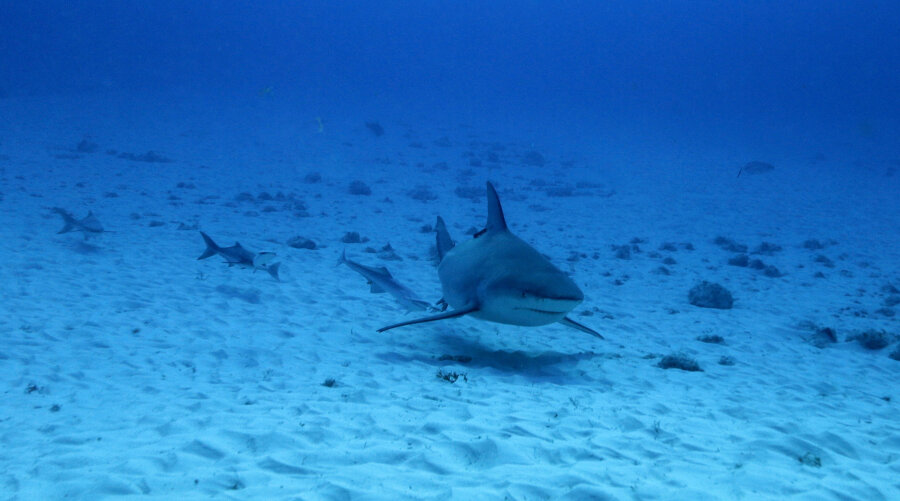Diving with sharks is a thrilling experience that offers an unparalleled glimpse into the lives of these magnificent creatures.
However, it also requires a high level of respect, awareness, and preparation to ensure safety for both divers and sharks.
This comprehensive guide explores the best practices and safety tips for diving with sharks, helping you make the most of your underwater adventures while protecting these vital marine predators.
Introduction to shark diving
Shark diving is an extraordinary activity that allows divers to observe and interact with sharks in their natural habitat.
Far from the fearsome reputation often portrayed in media, most sharks are not a threat to humans. Shark diving provides an opportunity to appreciate these animals up close and to learn more about their behaviors and ecological importance.
However, it requires careful planning and adherence to specific safety protocols to ensure a positive experience.
Understanding shark behavior
Understanding shark behavior is crucial for safe and enjoyable shark diving.
Sharks are generally curious and may approach divers out of interest, not aggression. Recognizing the signs of shark behavior, such as body language and movement patterns, can help divers anticipate their actions and respond appropriately.
Sharks are apex predators and play a crucial role in maintaining the balance of marine ecosystems.
They typically avoid conflict and are more interested in hunting fish than interacting with humans.
Shark body language
Sharks communicate through their body language.
A relaxed shark will swim smoothly and calmly, while a more agitated shark might display rapid movements, arch its back, or drop its pectoral fins.
Understanding these signals helps divers gauge the shark’s mood and behavior, allowing them to adjust their actions accordingly.
Feeding behavior
Sharks exhibit different feeding behaviors based on their species and environment.
Some sharks, like reef sharks, hunt in packs, while others, like great whites, are solitary hunters.
Recognizing these behaviors is important for divers to avoid inadvertently provoking a feeding response.
Preparing for a shark dive
Preparation is key to a successful and safe shark dive.
This involves selecting a reputable dive operator, undergoing proper training, and ensuring all equipment is in good condition.
Divers should also familiarize themselves with the specific species of sharks they will encounter and the local regulations and guidelines.
Selecting a reputable dive operator is crucial for a safe shark diving experience.
Look for operators with experienced guides, good safety records, and a commitment to shark conservation.
Reviews and recommendations from other divers can also be helpful in making an informed choice.
Training and Certification
Proper training is essential for shark diving.
Divers should be certified and have experience in open water diving before attempting a shark dive.
Specialized courses in shark diving can provide valuable knowledge and skills, including how to read shark behavior and respond to different situations underwater.
Discover the dive: ADVENTURE WITH THE BULL SHARK
Essential gear for shark diving
Having the right gear is essential for a successful shark dive.
This section outlines the essential equipment needed for shark diving and how to ensure it meets the necessary standards.
Wetsuits and drysuits
A good wetsuit or drysuit is essential for maintaining body temperature and protecting against abrasions.
The thickness of the suit depends on the water temperature and the duration of the dive.
In colder waters, a thicker suit or a drysuit is recommended.
Fins and masks
High-quality fins and masks are crucial for efficient movement and clear vision underwater. Fins should be comfortable and provide good propulsion, while masks should fit well and offer a wide field of view.
Buoyancy Control Device (BCD)
A reliable BCD is important for maintaining buoyancy and stability underwater.
It should be properly fitted and checked before each dive to ensure it functions correctly.
Dive computer
A dive computer helps monitor depth, time, and ascent rates, providing essential information for a safe dive.
It should be easy to read and use, with a backlight for low-light conditions.
Safety tips for diving with sharks
Safety is paramount when diving with sharks.
This section provides essential safety tips to help divers minimize risks and ensure a safe and enjoyable experience.
Maintain situational awareness
Divers should always be aware of their surroundings and the behavior of sharks.
Keeping a close eye on the sharks and other divers can help prevent accidents and ensure everyone’s safety.
Stay calm and avoid sudden movements
Remaining calm and avoiding sudden movements can help prevent sharks from becoming startled or aggressive.
Slow, deliberate movements signal to sharks that the diver is not a threat.
Keep a safe distance
Maintaining a safe distance from sharks is crucial.
Divers should respect the sharks’ space and avoid approaching them too closely.
Most guidelines recommend staying at least 10 feet away from the sharks.
Follow the guide’s instructions
Following the dive guide’s instructions is essential for safety.
Guides are experienced and knowledgeable about shark behavior and local conditions, and their advice can help prevent dangerous situations.
Discover the dive: MEET THE WHALE SHARK
The role of sharks in marine ecosystems
Sharks play a crucial role in maintaining the health and balance of marine ecosystems.
As apex predators, they help regulate the populations of other marine species, ensuring the stability of the food web.
Apex Predators
Sharks are apex predators, meaning they are at the top of the food chain.
They help control the populations of prey species, preventing any one species from becoming too dominant. This balance is essential for the health of marine ecosystems.
Indicators of ocean health
Sharks are indicators of ocean health.
Healthy shark populations suggest a well-balanced ecosystem, while declining shark numbers can signal underlying problems such as overfishing or habitat degradation. Protecting sharks is therefore crucial for the overall health of the oceans.
Importance of biodiversity
Sharks contribute to biodiversity by maintaining the balance of marine species. Biodiversity is essential for resilient ecosystems, as it allows for a greater variety of life forms to thrive and adapt to changing conditions. Protecting sharks helps preserve this biodiversity.
Myths and facts about sharks
Sharks are often misunderstood and surrounded by myths that contribute to their negative reputation. This section addresses common misconceptions and provides factual information about sharks.
Myth: sharks are man-eaters
One of the most pervasive myths is that sharks are man-eaters.
In reality, shark attacks on humans are extremely rare.
Most sharks are not interested in humans as prey, and when attacks do occur, they are usually cases of mistaken identity.
Myth: all sharks are dangerous
Not all sharks are dangerous.
There are over 500 species of sharks, and most are harmless to humans.
Only a few species, such as the great white, tiger, and bull sharks, are known to pose a potential threat, and even these species rarely attack humans.
Fact: sharks are threatened by human activities
Sharks face significant threats from human activities, including overfishing, habitat destruction, and pollution.
Many shark species are now endangered or vulnerable due to these pressures. Conservation efforts are essential to protect these important marine animals.
Frequently asked questions about shark diving
Is shark diving safe?
Shark diving is generally safe when conducted with experienced guides and proper safety protocols.
Understanding shark behavior and following guidelines can help minimize risks and ensure a positive experience.
Do I need special training for shark diving?
While general diving certification is required, specialized training in shark diving can enhance safety and enjoyment.
Courses cover shark behavior, safety tips, and best practices for interacting with sharks.
What should I do if a shark approaches me?
If a shark approaches, remain calm and avoid sudden movements.
Maintain eye contact and slowly back away if necessary. Do not provoke or touch the shark, and follow the instructions of your dive guide.
Can I use flash photography when diving with sharks?
Flash photography is generally discouraged, as it can startle sharks and other marine life. Use natural light or a dive light to illuminate your subject without causing disturbance.
How can I support shark conservation?
Supporting shark conservation can be done through advocacy, participating in conservation projects, and educating others about the importance of sharks.
Divers can also support organizations that work to protect shark populations and their habitats.
Conclusion
Diving with sharks is an exhilarating and educational experience that offers a unique perspective on these fascinating creatures.
By understanding shark behavior, preparing adequately, and following safety tips and best practices, divers can enjoy safe and memorable encounters with sharks.
Moreover, divers have a responsibility to support shark conservation efforts and advocate for the protection of these vital marine predators. Whether you are a seasoned diver or new to shark diving, embracing these principles will help ensure that both you and the sharks have a positive experience.
Ready to dive into an unforgettable shark diving adventure?
Pluto Dive provides everything you need for a safe and exceptional experience.
Contact Pluto Dive to book your next dive adventure:
Email: plutodive@gmail.com Phone: +52 984 151 9045 | +52 984 151 9046 Location: 40th Street between 5th and 10th avenues, Playa del Carmen, Mexico



